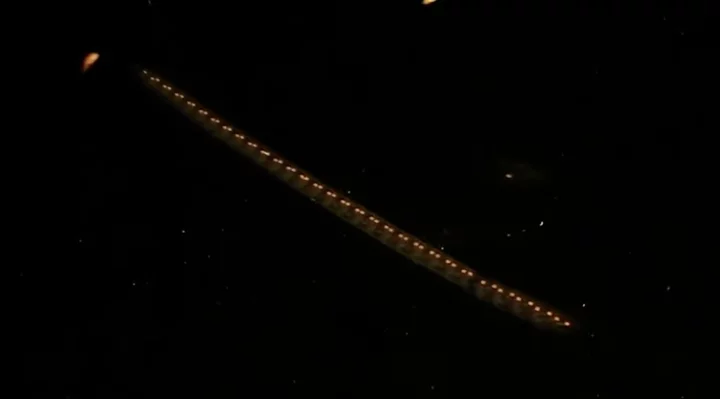The lightless deep sea is swirling with life.
New footage captured in the "twilight zone" — areas of the ocean starting at around 100 meters (330 feet) deep where sunlight can't reach — reveals a world teeming with often otherworldly organisms: long chains of creatures, tentacled life, defensive ink blasted into the water, and beyond.
These creatures were filmed around the Geologist Seamounts just south of the Hawaiian islands. The expedition, funded by the National Oceanic and Atmospheric Administration's ocean exploration division, allowed scientists to drop a sleek deep sea exploration vehicle, called Mesobot, into these dark waters. These remotely operated vehicles, or ROVs, can be intrusive to deep ocean life, but Mesobot, with a slim design and slow-moving propellers, is designed to avoid frightening wildlife away.
Each day, this marine life migrates to surface waters and then back down (to hide in the dark during daylight).
"These twilight zone organisms make up the largest animal migration on Earth and help the ocean regulate global climate by moving carbon from surface waters to the deep ocean, where it can remain sequestered from the atmosphere for centuries or millennia," the Woods Hole Oceanographic Institution, which built and operates Mesobot, said over email.
SEE ALSO: Scientists discover ancient shark swimming in a really strange placeThe video below, compiled by Woods Hole, is just over three and a half minutes long and comprises the best footage captured on the dive. Here are a few highlights:
- 0:39: A vibrant siphonophore — a complex colony of individual creatures chained together — moves through the frame
- 1:10: An oceanic whitetip shark glides through the water
- 02:55: A potent ink cloud is emitted from a squid
(Throughout the footage, the many critters captured on video are identified.)
Want more science and tech news delivered straight to your inbox? Sign up for Mashable's Light Speed newsletter today.
The deep sea remains a largely mysterious place, and just around 25 percent of the seafloor is decently mapped. Deep ocean missions are often considered the new exploration of little-known — or just never-visited — places on Earth.
"We always discover stuff when we go out into the deep sea. You're always finding things that you haven't seen before," Derek Sowers, an expedition lead for NOAA Ocean Exploration, told Mashable in 2022.
That's why deep sea exploration missions are so vital. Scientists want to shine a light — literally and figuratively — on what's down there. The implications of knowing are incalculable, particularly as deep sea mineral prospectors prepare to run tank-like industrial equipment across parts of the seafloor. For example, research expeditions have found that ocean life carries great potential for novel medicines. "Systematic searches for new drugs have shown that marine invertebrates produce more antibiotic, anti-cancer, and anti-inflammatory substances than any group of terrestrial organisms," notes NOAA.









